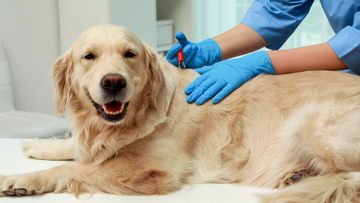Springtime, with its many pests and fleas that often bother dogs, is always a big problem. We know how to get rid of them.
The first rays of sunshine herald the beginning of spring, and both humans and animals are drawn to nature. Dog owners, in particular, enjoy long walks in the woods and fields with their canine companions. But this pure idyll also has a downside: intrusive parasites and pests that awaken with spring and can cause serious torment and, in some cases, even serious illness for our four-legged friends.
What exactly is a parasite?
Parasites are small organisms that infest dogs and sustain themselves by feeding on them. A distinction is made between ectoparasites and endoparasites.
The ectoparasite
Ectoparasites include ticks, fleas, and mites, which live on the dog's skin, ears, or fur, causing harm to its health. They usually lay their eggs there, from which their larvae hatch within a certain period of time and feed on the dog's blood or dander. This is obviously not good for the dog's health. All types of parasites put a strain on its immune system.
The endoparasite
The endoparasite lives inside the dog and nests in the gastrointestinal tract, lungs, or heart. This makes it very difficult to detect and often only noticed when symptoms appear. These worms, or Giardia, possess an incredible ability to adapt to ensure their survival.
Their preferred place to lay their eggs is the intestine of their host.
What signs indicate an ectoparasite infestation or endoparasite infestation?
Ectoparasite infestation
Ectoparasites can usually be detected with the naked eye, for example, when they seek a home in the dog's fur. In the case of a flea infestation, black crumbs can be seen on the dog's skin or in the dog's bed. Hair loss over a large area, itching, and the formation of dandruff are also clear signs of an ectoparasite infestation.
Endoparasite infestation
Determining the presence of endoparasites is often a real challenge for dog owners, as worms and Giardia are often invisible or only become apparent very late. However, they have long since accumulated internally and are affecting the animal's health. Symptoms indicating endoparasites include rattling noises in the respiratory tract, exhaustion, prolonged severe diarrhea, watery eyes, and loss of appetite.
The tick - the most well-known parasite of dogs
Ticks begin to become active at temperatures of 7-10 degrees Celsius, lurking in grass or bushes up to 1.5 meters high, waiting for their victims. Using the Haller organ located in its front legs, the tick can locate various substances in the breath or sweat of the dog and thus knows exactly where to find its host. Once it has found one, it settles on the dog and searches for a suitable spot in its fur, which it then opens with its mouthparts to suck blood. The pathogens in its saliva can transmit diseases such as
- Babesiosis
-
Lyme disease
-
Anaplasmosis
-
TBE
-
Ehrlichiosis
to the dog. There's no doubt that ticks pose a threat to the dog's health and well-being. In such cases, treatment with nutritional supplements can help. These can help the animal develop a stronger immune system. Then the infestation can be actively combated, and the dog will recover more quickly.
The miniature master with jumping talent
The flea has a third pair of legs, which can be described as jumping legs, allowing it to overcome 150 times its body length. This jumping power is exhausting for the flea, but nevertheless extremely effective for jumping onto its host. Flea bites are not only unpleasant for the animal companion due to the persistent itching, but also dangerous due to the induction of
-
Skin inflammation
-
typhus
-
Flea allergy
-
meningitis
The mite - digging is its passion
Burrowing mites and hair follicle mites are the most common mite species found in dogs.
The burrowing mite burrows up to 1 cm deep under the skin of its host animal, where it then lays its eggs.
The hair follicle mite has its domicile in the hair follicles of the dog, where it is completely
is normal. Only when it can multiply uncontrollably due to a weakened immune system and health, or due to a genetic defect, does the hair follicle mite become a problem. In the worst cases, mites cause diseases such as demodicosis and mange.
Worms - A danger inside that should not be underestimated
Tapeworms and roundworms are the most common in dogs and are often only detected very late because their habitat is inside the animal. The health of the animal is severely affected by a worm infestation. They are primarily ingested through the feces of infected animals when sniffing. There they live and feed on the animal's intestines, which is not without consequences and can lead to
-
constipation
-
itching
-
vomiting and diarrhea
-
Deficiency symptoms due to nutrient deprivation
-
Wormbelly
-
loss of appetite
-
Weight loss
becomes noticeable.
Giardia - Persistent tenant in the dog intestine
Giardia are also very small and live in the small intestine of their host, but they are nevertheless
not worms, but single-celled parasites.
The possibilities of infection are manifold and range from contaminated water in puddles and
Lakes, contaminated soil and contact with conspecifics.
Their resilience is legendary, so survival for years is possible.
They cause:
-
Gastrointestinal problems
-
abdominal cramps
-
Vomit
-
flatulence
Our IMUN Dog “Para” – Valuable support against parasites and worms in dogs
Made from natural raw materials, our Imun Dog “Para” presents itself due to its
antiviral and antibacterial spectrum as effective support for the defense against parasites and worms.
GMO-free, premium quality and with high bioavailability, it supports
excellently supports your four-legged friend's natural defenses.
With a strengthened immune system, fighting off parasites and worms becomes child's play.
As well as reducing itching, intestinal and coat problems.












